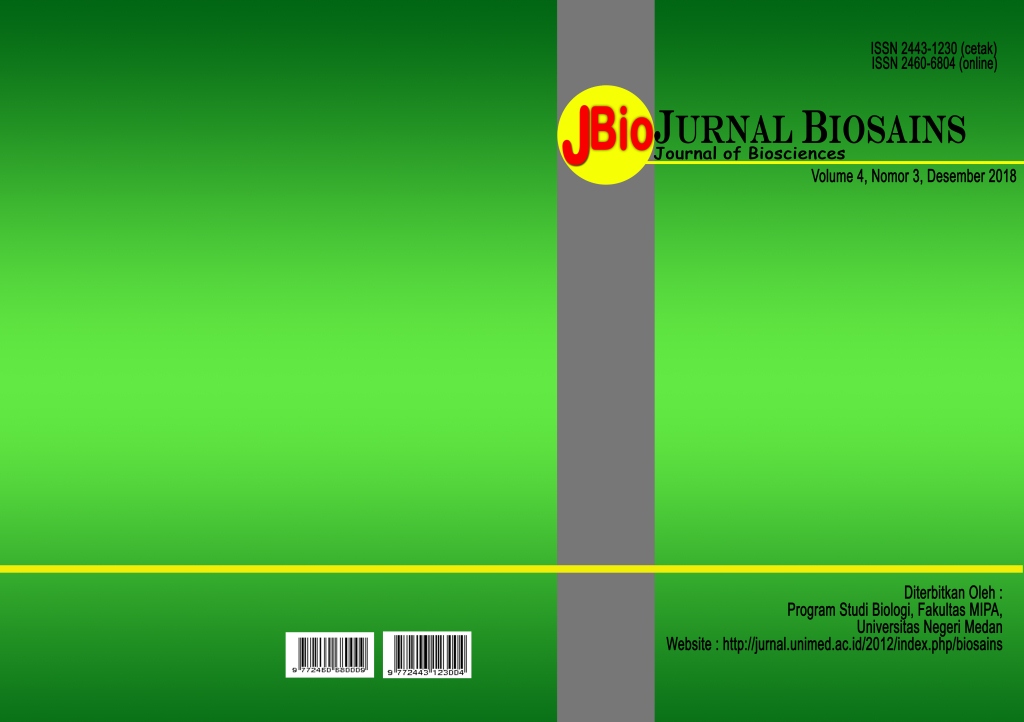KAPANG DENGAN AKTIVITAS FIBRINOLITIK YANG DIISOLASI DARI TANAH RUMAH POTONG HEWAN
DOI:
https://doi.org/10.24114/jbio.v4i3.11354Abstract
Tujuan penelitian ini untuk mendapatkan kapang fibrinolitik yang unggul daalm menghasilkan enzim fibrinolitik. Isolasi kapang dilakukan dengan metode spread plate pada Potato Dextrose Agar. Seleksi kemampuan proteolitik dan fibrinolitik dilakukan pada Skim Milk Agar dan fibrin plate agar. Seleksi isolat berdasarkan indeks aktivitas enzim yang diperoleh dengan membagi diameter zona jernih di sekeliling koloni dengan diameter koloni. Hasil seleksi memperoleh 41 isolat kapang fibrinolitik. Lima isolat kapang dari 41 isolat kapang fibrinolitik mempunyai indeks aktivitas enzim 10. Isolat tersebut teridentifikasi sebagai anggota dari Aspergillus (isolat S3, S4 dan R5) dan Penicillium (isolat G1 dan G2).References
Alexopoulos, C.J., C.W. Mims and M. Blackwell. 1996. Intoductory Mycology. John Wiley and Sons Inc, New York.
Bakta, I.M. 2007. Hematologi Klinik Ringkas. EGC, Jakarta.
Domsch, K.H., W. Gams and T.H. Anderson. 1980. Compendium of Soil Fungi. Academic Press, London.
Kemenkes RI. 2013. Riset Kesehatan Dasar 2013. Badan Penelitian dan Pengembangan Kesehatan
Kim, S.H and Choi, N.S. 2000. Purification and Characterization of Subtilisin DJ-4 Secreted by Bacillus sp. Strain DJ-4 Screened from Doen-Jong. Biosci. Biotechnol. Biochem. 64: 1722-1725.
Muisristanto, D., A. Poernomo, and T. Sugijangto. 20015. Isolasi dan Penapisan Fibrinolitik Jamur Tanah Hutan Mangrove Wonorejo Surabaya. Berkala Ilmiah Kimia Farmasi. 4 (2) : 11-17.
Padmono, D. 2005. Alternatif Pengolahan Limbah Rumah Potong Hewan- Cakung. Jurnal Teknik Lingkungan. 6 (1): 303-310.
Peng, Y., X. Yang and Y. Zhang. 2005. Microbial Fibrinolytic Enzymes : An Overview of Source, Production, Properties, and Thrombolytic Activity In Vivo. Appl. Microb. Biotechnol. 69: 126-132.
Poernomo, A., Isnaeni and Purwanto. 2015. Aktivitas Invitro Enzim Fibrinolitik Ekstrak Tempe Hasil Fermentasi Rhizopus oligosporus ATCC 6010 pada Substrat Kedelai Hitam. Berkala Ilmiah Kimia Farmasi. 4 (2): 18-24.
Risris, N., Y. Sastro and B. Bakrie. 2011. Karakteristik Fisik, Kimia dan Biologi dari Tepung Limbah Rumah Potong Ayam sebagai Bahan Baku untuk Pakan Ternak. Di dalam: Seminar Nasional Teknologi Peternakan dan Veteriner; Jakarta. Balai Pengkajian Teknologi Pertanian, Jakarta. 651-659.
Saha, A., P. Mandal, S. Dasgupta and D. Saha. 2008. Influence of Culture Media and Environmental Factors on Mycelial Growth and Sporulation of Lasiodiplodia theobromae (Pat) Griffon and Maub. Journal of Environmental Biology. 29 (3): 407-410.
Samson, R.A., E. S. Hoekstra, J.C Frisvad and O. Filtenborg. 1995. Introduction to Food-Borne Fungi. Fourth Edition. Centraalbureau Voor Schimmelcultures, The Netherlands.
Setiawan, A., Arimurti, S., Senjarini, K., & Sutoyo. (2016). Aktivitas Proteolitik dan Fibrinolitik Isolat Bakteri dari Perairan Pantai Papuma Kabupaten Jember. Berkala Sainstek, 4(1): 1-4.
Downloads
Published
Issue
Section
License
Copyright (c) 2018 Nur Khikmah, Nunung Sulistyani

This work is licensed under a Creative Commons Attribution 4.0 International License.
For Authors Jurnal Biosains agree to the following terms:
Authors retain copyright and grant the Jurnal Biosains (JBIO) right of first publication with the work simultaneously licensed under a Creative Commons Attribution License (CC BY-SA 4.0) that allows others to share (copy and redistribute the material in any medium or format) and adapt (remix, transform, and build upon the material) the work for any purpose, even commercially with an acknowledgement of the work's authorship and initial publication in JBIO (Jurnal Biosains)
Authors are able to enter into separate, additional contractual arrangements for the non-exclusive distribution of the journal's published version of the work (e.g., post it to an institutional repository or publish it in a book), with an acknowledgement of its initial publication in JBIO (Jurnal Biosains)
Authors are permitted and encouraged to post their work online (e.g., in institutional repositories or on their website) prior to and during the submission process, as it can lead to productive exchanges, as well as earlier and greater citation of published work (See The Effect of Open Access).


